Traces of Honeybees, Api-Tourism and Beekeeping: From Past to Present
Abstract
1. Introduction
2. From Past to Present
3. Use of Bee Products as Food and Beverages
4. Api-Air (Hive Air) Therapy
5. Apitherapy
6. Api-Tourism
7. Conclusions
Author Contributions
Funding
Institutional Review Board Statement
Data Availability Statement
Acknowledgments
Conflicts of Interest
References
- Wadley, L.; Trower, G.; Backwell, L.; D’Errico, F. Traditional Glue, Adhesive and Poison Used for Composite Weapons by Ju/’hoan San in Nyae Nyae, Namibia. Implications for the Evolution of Hunting Equipment in Prehistory. PLoS ONE 2015, 10, e0140269. [Google Scholar] [CrossRef]
- Sano, K.; Arrighi, S.; Stani, C.; Aureli, D.; Boschin, F.; Fiore, I.; Spagnolo, V.; Ricci, S.; Crezzini, J.; Boscato, P.; et al. The earliest evidence for mechanically delivered projectile weapons in Europe. Nat. Ecol. Evol. 2019, 3, 1409–1414. [Google Scholar] [CrossRef]
- Graham, J.M. The Hive and the Honey Bee; Dadant & Sons: Hamilton, IL, USA, 2015. [Google Scholar]
- Fontana, C.; Fontana, P. The first evidence. In Italian Apiculture. A Journey through History and Honey Diversity; Part I; Floris, I., Ed.; Accademia Nazionale Italiana di Entomologia: Firenze, Italy, 2020; pp. 36–47. ISBN 9788896493212. [Google Scholar]
- Eroğlu, Ö.; Yuksel, S. Historical development and current status of beekeeping in Turkey and the World. ATLAS J. 2020, 6, 345–354. [Google Scholar] [CrossRef]
- Kritsky, G. Beekeeping from antiquity through the Middle Ages. Annu. Rev. Entomol. 2017, 62, 249–264. [Google Scholar] [CrossRef]
- Bakan, A. Balın gizemi. Bilim Ve Tek. Derg. Yıldız Takımı Eki 2009, 10, 8–11. [Google Scholar]
- Langstroth, L. Hive and the Honeybee, 1st ed.; Hopkins, Bridgman & Company: Greenfield, MA, USA, 1853; pp. 143–172, print. [Google Scholar]
- Movna, U. Beekeeping: Ukrainian Ritual Context; Language: Lviv, Ukraine, 2017; p. 552. ISBN 978-966-02-8534-7. [Google Scholar]
- Jones, R. A Short History of Beekeeping in the Ukraine. Bee World 2013, 90, 12–14. [Google Scholar] [CrossRef]
- Šivic, F. Apitourism: A fusion of apiculture and travel in verdant lands. Bee World 2013, 90, 66–67. [Google Scholar] [CrossRef]
- Kösoğlu, M.; Özdemir, A.; Baysan, S.; Akar-Vural, R.; İnci, E.; Kiraz, D.E.; Gençsoylu, İ.; Boz, Ö.; Hazır, C.; Ertuğrul, F. Çine Arıcılık Müzesinde Ekoloji Temelli Doğa Eğitimi. Anadolu Doğa Bilimleri Dergisi 2011, 2, 24–33. [Google Scholar]
- Curca, D.; Andronie, I.C.; Andronie, V. From the history of the Romanian apiculture. Econ. Manag. Financ. Mark. 2011, 6, 1124. [Google Scholar]
- Augustina, M. Beehives with paintings on the front wall in the Radovljica apicultural museum. Rev. Fr. Apic. 1978, 360, 25–28. [Google Scholar]
- Kösoğlu, M. Kişisel Arı Figürlü Pul Ve Para Koleksiyonu; İzmir, Turkey, 2021. [Google Scholar]
- Semkiw, P.; Skubida, P. Bee Bread Production—A New Source of Income for Beekeeping Farms? Agriculture 2021, 11, 468. [Google Scholar] [CrossRef]
- Topal, E.; Ceylan, Ö.; Kösoğlu, M.; Margaoan, R.; Cornea-Cipcigan, M. Bal Mumunun Yapısı, Kullanım Alanları ve Bazı Temel Sorunları. Uludağ Arıcılık Dergisi 2020, 20, 209–220. [Google Scholar] [CrossRef]
- Adanacıoğlu, H.; Kösoğlu, M.; Saner, G.; Topal, E.; Yücel, B. Economic Feasibility of Package Beekeeping Application in Turkey: A Case Study of Edirne Province. Kafkas Univ. Vet. Fak. Derg. 2019, 25, 651–658. [Google Scholar] [CrossRef]
- Vilas-Boas, M. Diversification as a tool for sustainable beekeeping: Are international standards a bottleneck? In Proceedings of the 6th International Mugla Beekeeping & Pine Honey Congress, Muğla, Turkey, 15–19 October 2018. [Google Scholar]
- Özcan, E.S. Balarısının uzun tarihinden kısa notlar. TÜBİTAK Bilim ve Teknik Dergisi 2014, 1, 64–67. [Google Scholar]
- Ilyasov, R.A.; Kosarev, M.N.; Neal, A.; Yumaguzhin, F.G. Burzyan Wild-Hive Honeybee A.M. mellifera in South Ural. Bee World 2015, 92, 7–11. [Google Scholar] [CrossRef]
- Harissis, H.V. Beekeeping in prehistoric Greece. In Proceedings of the International Symposium: Beekeeping in the Mediterranean from Antiquity to the Present, Syros, Greece, 9–11 October 2014; pp. 14–35. [Google Scholar]
- Anderson-Stojanovic, V.R.; Jones, J.E. Ancient beehives from Isthmia. Hesperia 2002, 71, 345–376. [Google Scholar] [CrossRef]
- Bonet, H.R.; Mata, C.P. The archaeology of beekeeping in pre-Roman Iberia. J. Mediterr. Archaeol. 1997, 10, 33–47. [Google Scholar]
- Jones, J.E.; Graham, A.J.; Sackett, L.H. An Attic Country House below the Cave of Pan at Vari. Annu.Br. Sch. Athens 1973, 68, 355–452. [Google Scholar] [CrossRef]
- Crane, E.; Graham, A.J. Bee hives of the ancient world. 2. Bee World 1985, 66, 148–170. [Google Scholar] [CrossRef]
- Harissis, H.V.; Mavrofridis, G. A 17th Century Testimony on the Use of Ceramic Top-bar Hives. Bee World 2012, 89, 56–58. [Google Scholar] [CrossRef]
- Engel, M.; AlQarni, A.S.; Hannan, M.A.; Owayss, A.A. The indigenous honey bees of Saudi Arabia (Hymenoptera, Apidae, Apis mellifera jemenitica Ruttner): Their natural history and role in beekeeping. ZooKeys 2011, 134, 83–98. [Google Scholar] [CrossRef]
- Harissis, H.V.; Harissis, A.V. Apiculture in the Prehistoric Aegean: Minoan and Mycenaean Symbols Revisited; BAR Publishing: Oxford, UK, 2009. [Google Scholar] [CrossRef]
- Yazıcı, G.A.; Üreten, H. Ephesos Kenti Tanrı (ça) ve Kültleri. Akademik Tarih ve Düşünce Dergisi 2020, 7, 452–495. [Google Scholar]
- Hatjina, F.; Mavrofridis, G.; Jones, R. Beekeeping in the Mediterranean from Antiquity to the Present; Division of Apiculture Hellenic Agricultural Organization “Demeter”: Nea Moudania, Greece, 2018; pp. 18–39. Available online: https://www.apiservices.biz/documents/articles-en/beekeeping_in_mediterranean.pdf (accessed on 8 October 2021).
- Pruess, K.P. Postage Stamps Showing Bees and Hives. Bee World 1973, 54, 53–56. [Google Scholar] [CrossRef]
- Shaw, D.E.; Ching, J.S. Bee and Bee Interest Postage Stamps of the World: Supplement 1. Bee World 1994, 75, 181–193. [Google Scholar] [CrossRef]
- Elba Island (Tuscany, Italy). 2021. Available online: https://www.crwflags.com/fotw/flags/it-elba.html (accessed on 9 August 2021).
- Kösoğlu, M. Çine Arıcılık Müzesi. Apelasyon Dergisi, sayı 14. 2015. Available online: http://apelasyon.com/Yazi/194-cine-aricilik-muzesi (accessed on 9 August 2021).
- Carlson, R.D. The Honey Bee and Apian Imagery in Classical Literature. Chapter 1. Ph.D. Thesis, University of Washington, Seattle, WA, USA, 2015; p. 19. [Google Scholar]
- Bulut, S.; Lenger, D. Antik Dönemde Arı Ürünlerinin Kullanımı. Arı Ürünleri ve Sağlığı (Apiterapi); Sidas Medya Ltd. Sti.: Izmir, Turkey, 2015; pp. 7–16. ISBN 978-605-5267-26-1. [Google Scholar]
- Floris, I.; Fontana, P. Honeybees and beekeeping in ancient Rome. In Italian Apiculture. A Journey through History and Honey Diversity, Part I; Floris, I., Ed.; Accademia Nazionale Italiana di Entomologia: Firenze, Italy, 2020; pp. 48–71. ISBN 9788896493212. [Google Scholar]
- Floris, I.; Pusceddu, M.; Satta, A. Sardinian beekeeping. In Italian Apiculture. A Journey through History and Honey Diversity; Part I; Floris, I., Ed.; Accademia Nazionale Italiana di Entomologia: Firenze, Italy, 2020; pp. 244–266. ISBN 9788896493212. [Google Scholar]
- Khmelnytska, L. EBOЛЮЦIЯ TPAДИЦIЙHOЇ CИCTEMИ XAPЧУBAHHЯ УKPAЇHЦIB. Sci. Notes Ukr. Hist. 2019, 46, 49–56. [Google Scholar] [CrossRef]
- Dalby, A.; Grainger, S. The Classical Cookbook; Getty Publications: Los Angeles, CA, USA, 1996. [Google Scholar]
- Kılıçbay, M.A. İnsanlığın İlk İçkisi: Hidromel. Ballı yazılar. Gastro Dizisi IV; Metro Kültür Yayınları: Istanbul, Turkey, 2010. [Google Scholar]
- Bilgin, A. Osmanlı Sarayında Bal ve Şekerin Tedarik, Tüketim ve Rekabeti. Ballı yazılar. Gastro Dizisi IV; Metro Kültür Yayınları: Istanbul, Turkey, 2010. [Google Scholar]
- Melnychuk, Y.; Karabin, B. To Pour Full Glasses. A Word in Defense of Bacchus; Vydavnyche Pidpryiemstvo «Krai»: Lviv, Ukraine, 1992. [Google Scholar]
- Sushko, V.L. A Practical Guide to Homemade Honey Brewing and Making Berry and Fruit Honey Wines; Vitebskaya Guberniya, Belarus, 1891; (In Ancient East Slavic). [Google Scholar]
- Kablukov, I.; Pisarev, V. About Wine Making from Honey; Vitebskaya Guberniya, Moscow, 1899; (In Ancient East Slavic). [Google Scholar]
- Adamchuk, L.; Brindza, J.; Lypko, K. Honey drinks. Honey Drinks 2020, 156, 9788055222769. [Google Scholar] [CrossRef]
- Hornich, M. Honey Wines. How to Make Honey Wine at Home; Kyiv, Dim, Sad, Horod: Kyiv, Ukraine, 2019; p. 180. ISBN 978-966-2471-27-4. [Google Scholar]
- Mărgăoan, R.; Cornea-Cipcigan, M.; Topal, E.; Kösoğlu, M. Impact of Fermentation Processes on the Bioactive Profile and Health-Promoting Properties of Bee Bread, Mead and Honey Vinegar. Processes 2020, 8, 1081. [Google Scholar] [CrossRef]
- Mărgăoan, R.; Stranț, M.; Varadi, A.; Topal, E.; Yücel, B.; Cornea-Cipcigan, M.; Campos, M.G.; Vodnar, D.C. Bee Collected Pollen and Bee Bread: Bioactive Constituents and Health Benefits. Antioxidants 2019, 8, 568. [Google Scholar] [CrossRef]
- Yucel, B.; Topal, E.; Kosoglu, M. Bee Products as Functional Food. In Superfood and Functional Food—An Overview of Their Processing and Utilization; IntechOpen: London, UK, 2017; pp. 15–33. [Google Scholar] [CrossRef]
- Ajibola, A.; Chamunorwa, J.P.; Erlwanger, K.H. Nutraceutical values of natural honey and its contribution to human health and wealth. Nutr. Metab. 2012, 9, 61. [Google Scholar] [CrossRef]
- Bobiș, O.; Mărghitaș, L.A.; Dezmirean, D.; Morar, O.; Bonta, V.; Chirilă, F. Quality parameters and nutritional value of different commercial bee products. Bulletin of university of agricultural sciences and veterinary medicine Cluj-Napoca. Anim. Sci. Biotechnol. 2010, 67, 91–96. [Google Scholar]
- EFSA (European Food Safety Authority). Scientific Opinion on Pyrrolizidine Alkaloids in Food and Feed. EFSA J. 2011, 9, 2406. [Google Scholar] [CrossRef]
- Petersen, A. Dietary exposure assessment to pyrrolizidine alkaloids in the European population. EFSA J. 2016, 14, 14. [Google Scholar] [CrossRef]
- Ferrazzi, P.; Vercelli, M.; Contessi, A. Pericolosità Di Certi Nettari e Pollini. Apinsieme 2017, 6, 38–44. [Google Scholar]
- Lucchetti, M.A.; Glauser, G.; Kilchenmann, V.; Dübecke, A.; Beckh, G.; Praz, C.; Kast, C. Pyrrolizidine Alkaloids from Echium vulgare in Honey Originate Primarily from Floral Nectar. J. Agric. Food Chem. 2016, 64, 5267–5273. [Google Scholar] [CrossRef]
- Adamchuk, L.; Brovarskyi, V.; Brindza, J. Apply honey in wellness drinks. Organic Agriculture for Agrobiodiversity Preservation. In 3rd International Conference Agrobiodiversity “Organic Agriculture for Agrobiodiversity Preservation” Book of Abstract, 1–3 June 2017, Novi Sad, Serbia; University of Novi Sad: Novi Sad, Serbia, 2017. [Google Scholar]
- Özcan, M.; Fındık, S.; Uylaşer, V.; Çoban, D.İ. Investigation of the Physical and Chemical Properties of Traditional Homemade Yogurt with Different Rates of Pollen Additions. Avrupa Bilim Ve Teknol. Derg. 2020, 20, 516–521. [Google Scholar]
- Mironova, I.V.; Galieva, Z.A.; Konovalov, S.A.; Bychkova, T.S.; Baydan, D.V.A.; Rozhkov, K. Enrichment of milk ice cream with bee products. IOP Conf. Ser. Earth Environ. Sci. 2020, 613, 012082. [Google Scholar] [CrossRef]
- Zlatev, Z.; Taneva, I.; Baycheva, S.; Petev, M. A comparative analysis of physico-chemical indicators and sensory characteristics of yogurt with added honey and bee pollen. Bulg. J. Agric. Sci. 2018, 24, 132–144. [Google Scholar]
- Topal, E.; Doğaroğlu, M.; Yücel, B.; Varadi, A.; Strant, M.; Karaca, Ü. Arıcılıkta Ürün Çeşitliliğinin Arttırılması ve Pazarlama Stratejileri; Meta Basım Matbacılık Hizmetleri: İzmir, Turkey, 2016; ISBN 978-605-9175-54-8. [Google Scholar]
- Moriyama, H.; Bagchi, M.; Bagchi, D. Royal Jelly in Medicinal to Functional Energy Drinks. In Sustained Energy for Enhanced Human Functions and Activity; Elsevier BV: Amsterdam, The Netherlands, 2017; pp. 281–298. [Google Scholar]
- Balogu, T.V.; Towobola, O. Production and quality analysis of wine from honey and coconut milk blend using Saccha-romyces cerevisiae. Fermentation 2017, 3, 16. [Google Scholar] [CrossRef]
- Koguchi, M.; Saigusa, N.; Teramoto, Y. Production and Antioxidative Activity of Mead Made from Honey and Black Rice (Oryza sativa var. Indica cv. Shiun). J. Inst. Brew. 2009, 115, 238–242. [Google Scholar] [CrossRef]
- Gupta, J.K.; Sharma, R. Production technology and quality characteristics of mead and fruit-honey wines: A review. Indian J. Nat. Products Resour. 2009, 8, 345–355. [Google Scholar]
- Romano, R.; Aiello, A.; De Luca, L.; Sica, R.; Caprio, E.; Pizzolongo, F.; Blaiotta, G. Characterization of a new type of mead fermented with Cannabis sativa L. (hemp). J. Food Sci. 2021, 86, 874–880. [Google Scholar] [CrossRef]
- Hayakawa, K.; Mishima, K.; Fujiwara, M. Therapeutic Potential of Non-Psychotropic Cannabidiol in Ischemic Stroke. Pharmaceuticals 2010, 3, 2197–2212. [Google Scholar] [CrossRef]
- Laun, A.S.; Shrader, S.; Brown, K.J.; Song, Z.-H. GPR3, GPR6, and GPR12 as novel molecular targets: Their biological functions and interaction with cannabidiol. Acta Pharmacol. Sin. 2019, 40, 300–308. [Google Scholar] [CrossRef]
- Araújo, G.S.; Sampaio, K.F.; Santos, F.S.; Bastos, T.D.S.; Oliveira, P.P.; de Carvalho, G.B.M.; de Souza, S.M.A.; Martínez, E.A. Biochemical, physicochemical and melissopalynological analyses of two multifloral honey types from Brazil and their influence on mead production. J. Apic. Res. 2021, 60, 784–796. [Google Scholar] [CrossRef]
- Steinkraus, K.H.; Morse, R.A. Factors Influencing the Fermentation of Honey in Mead Production. J. Apic. Res. 1966, 5, 17–26. [Google Scholar] [CrossRef]
- Majtanova, N.; Cernak, M.; Majtan, J. Honey: A Natural Remedy for Eye Diseases. Complement. Med. Res. 2016, 23, 364–369. [Google Scholar] [CrossRef] [PubMed]
- Terzo, S.; Mulè, F.; Amato, A. Honey and obesity-related dysfunctions: A summary on health benefits. J. Nutr. Biochem. 2020, 82, 108401. [Google Scholar] [CrossRef] [PubMed]
- Alvarez-Suarez, J.M.; Gasparrini, M.; Forbes-Hernández, T.Y.; Mazzoni, L.; Giampieri, F. The Composition and Biological Activity of Honey: A Focus on Manuka Honey. Foods 2014, 3, 420–432. [Google Scholar] [CrossRef]
- Patel, S.; Cichello, S. Manuka honey: An emerging natural food with medicinal use. Nat. Prod. Bioprospecting 2013, 3, 121–128. [Google Scholar] [CrossRef]
- Mărgăoan, R.; Topal, E.; Balkanska, R.; Yücel, B.; Oravecz, T.; Cornea-Cipcigan, M.; Vodnar, D. Monofloral Honeys as a Potential Source of Natural Antioxidants, Minerals and Medicine. Antioxidants 2021, 10, 1023. [Google Scholar] [CrossRef]
- Kopała, E.; Balcerak, M.; Kuźnicka, E. Survey of consumer preferences on the bee product market. Part 1. Honey. Ann. Wars. Univ. Life Sci. SGGW Anim. Sci. 2019, 58, 153–158. [Google Scholar] [CrossRef]
- Maennle, H.; Riepen, T.; Muenstedt, K. Apitherapeutic means and patients’ willingness to accept them. J. Apitherapy 2020, 7, 15. [Google Scholar] [CrossRef]
- Gontarz, A.; Błońska, I.; Socha, S. Analiza preferencji konsumenckich studentów dotycząca miodów pszczelich. Wiad. Zoot. 2016, 4, 61–76. [Google Scholar]
- Przybyłowski, P.; Wilczewska, A. Zachowania kobiet w zakresie zastosowania miodu i produktów pszczelich w kosmetyce. Mark. Zarządzanie 2017, 48, 73–83. [Google Scholar] [CrossRef][Green Version]
- El-Wahed, A.A.A.; Farag, M.A.; Eraqi, W.A.; Mersal, G.A.; Zhao, C.; Khalifa, S.A.; El-Seedi, H.R. Unravelling the beehive air volatiles profile as analysed via solid-phase microextraction (SPME) and chemometrics. J. King Saud Univ. Sci. 2021, 33, 101449. [Google Scholar] [CrossRef]
- Bengsch, E. Studie über Potenzial der Biomedizinischen Wirksamkeit von Inhalierter Bienenluft; Max Planck-Institute: Munich, Germany, 2014; p. 4. Available online: https://www.chm.tu-dresden.de/lc3/dateien/stockluft.pdf (accessed on 9 August 2021).
- Musch, H. ApiAir—Die Bienenlufttherapie. 2014. Available online: https://www.apiair-musch.de/ (accessed on 9 September 2021).
- Uccusic, P. Bienenprodukte: Ihre Heilkraft und Anwendung; Ariston: Genf, Switzerland, 1985; p. 198. ISBN 3-453-06997-8. [Google Scholar]
- Dvykaliuk, R.M.; Adamchuk, L.O. Development of a Device for Obtaining Beehive Air Condensate. UDK 638.142.6-8:139.6-8:147.7. 2019. Available online: https://elibrary.ru/item.asp?id=37229940 (accessed on 20 June 2021).
- Dvykaliuk, R.M.; Adamchuk, L.O. Condensation Frame to Reduce Humidity Inside the Hive and Extract Condensate. Patent No 129535 Ukraine: MPK A01K47/06, A01K49/00. №u201808629, Bul. No 20, 25 October 2018. (In Ukrainian). [Google Scholar]
- Dvykalyuk, S.R.; Adamchuk, L.A. Development of A Device for Obtaining Course Air Condensate. Improving the Level and Quality of Biogenic Potential in Livestock. In Proceedings of the IV International Scientific and Practical Conference, Yaroslavl, Russia, 24 October 2018; pp. 13–17. [Google Scholar]
- Malone, M.; Tsai, G. Wound Healing with Apitherapy: A Review of the Effects of Honey. J. Apitherapy 2016, 1, 29. [Google Scholar] [CrossRef]
- Şenel, E.; Demir, E. Bibliometric analysis of apitherapy in complementary medicine literature between 1980 and 2016. Complement. Ther. Clin. Pract. 2018, 31, 47–52. [Google Scholar] [CrossRef] [PubMed]
- Fratellone, P.M.; Tsimis, F.; Fratellone, G. Apitherapy Products for Medicinal Use. J. Altern. Complement. Med. 2016, 22, 1020–1022. [Google Scholar] [CrossRef] [PubMed]
- Doğaroğlu, M. Arı ürünleri, apiterapi ve apimedica. In Proceedings of the Uluslararası Marmaris Apiterapi Kongresi, Marmaris, Turkey, 20–22 October 2015. [Google Scholar]
- Çakmak, İ. Apiterapi. Uludağ Arıcılık Dergisi 2001, 1, 16–18. [Google Scholar]
- Ali, A.M.; Kunugi, H. Apitherapy for Parkinson’s Disease: A Focus on the Effects of Propolis and Royal Jelly. Oxidative Med. Cell. Longev. 2020, 2020, 1–18. [Google Scholar] [CrossRef] [PubMed]
- Münstedt, K.; Männle, H. Apitherapy for menopausal problems. Arch. Gynecol. Obstet. 2020, 302, 1495–1502. [Google Scholar] [CrossRef]
- Sforcin, J.M.; Bankova, V.; Kuropatnicki, A.K. Medical Benefits of Honeybee Products. Evidence-Based Complement. Altern. Med. 2017, 2017, 1–2. [Google Scholar] [CrossRef]
- Trumbeckaite, S.; Dauksiene, J.; Bernatoniene, J.; Janulis, V. Knowledge, Attitudes, and Usage of Apitherapy for Disease Prevention and Treatment among Undergraduate Pharmacy Students in Lithuania. Evid. Based Complement. Altern. Med. 2015, 2015, 1–9. [Google Scholar] [CrossRef] [PubMed]
- Özçelikay, G.; Aykaç, G.; Uzun, M.B. “Bal”ın Eczacılıkta Kullanımı. Mersin Üniversitesi Tıp Fakültesi Lokman Hekim Tıp Tar. ve Folk. Tıp Derg. Lokman Hekim J. 2013, 9, 88. [Google Scholar]
- Ahuja, V.; Ahuja, A. Apitherapy—A sweet approach to dental diseases. Part II: Propolis. J. Adv. Oral Res. 2011, 2, 1–8. [Google Scholar] [CrossRef]
- Kocot, J.; Kiełczykowska, M.; Luchowska-Kocot, D.; Kurzepa, J.; Musik, I. Antioxidant Potential of Propolis, Bee Pollen, and Royal Jelly: Possible Medical Application. Oxid. Med. Cell. Longev. 2018, 2018, 1–29. [Google Scholar] [CrossRef] [PubMed]
- Cassaignau, C. L’Abeille et les Produits de la Ruche Utilisés en Nutrition et en Thérapeutique. Ph.D. Thesis, 1991. [Google Scholar]
- Molan, P. Why honey is effective as a medicine: 2. The scientific explanation of its effects. Bee World 2001, 82, 22–40. [Google Scholar] [CrossRef]
- Emonet, H. Étude de la médecine égyptienne antique et de sa pharmacopée: Le papyrus Ebers. Th. Doct. Pharm. Tours. 2001, 2001, 1–105. [Google Scholar]
- Contessi, A.; Celli, G. Le api: Biologia, Allevamento, Prodotti, 4th ed.; Edagricole: Bologna, Italy, 1983; pp. 137–145. [Google Scholar]
- Houghton, P.J. Propolis as a medicine. Are there scientific reasons for its reputation? In Beeswax and Propolis for Pleasure and Profit; Munn, P., Ed.; International Bee Research Association: Cardiff, UK, 1998; p. 10. [Google Scholar]
- Derevici, A.; Popesco, A.; Popesco, N. Biological properties of propolis. Rev. Pathol. Comp. 1965, 2, 21–24. [Google Scholar]
- Bogdanov, S.; Henry, K. Propolis: Composition, Health, Medicine: A Review. Bee Product Sci. 2012, 4, 1–35. [Google Scholar]
- Bostock, J.; Riley, H.T. Perseus at Tufts, Book XXII, The Properties of Plants and Fruits. In Pliny the Elder: The Natural History; Taylor and Francis: London, UK, 1855. [Google Scholar]
- Fratini, F.; Cilia, G.; Mancini, S.; Felicioli, A. Royal Jelly: An ancient remedy with remarkable antibacterial properties. Microbiol. Res. 2016, 192, 130–141. [Google Scholar] [CrossRef]
- Shen, X.; Liu, Y.; Luo, X.; Yang, Z. Advances in Biosynthesis, Pharmacology, and Pharmacokinetics of Pinocembrin, a Promising Natural Small-Molecule Drug. Molecules 2019, 24, 2323. [Google Scholar] [CrossRef] [PubMed]
- Goes, A.T.; Jesse, C.R.; Antunes, M.S.; Ladd, F.V.L.; Ladd, A.A.L.; Luchese, C.; Boeira, S.P. Protective role of chrysin on 6-hydroxydopamine-induced neurodegeneration a mouse model of Parkinson’s disease: Involvement of neuroinflam-mation and neurotrophins. Chem.-Biol. Interact. 2018, 279, 111–120. [Google Scholar] [CrossRef] [PubMed]
- Jelidi, S. Utilization of bee products from Trás-os-Montes on the development of cosmetic formulation with terpenes preservatives from aromatic plants. In Proceedings of the 1st Online Congress on Natural Products Application: Health, Cosmetic and Food, Escola Superior Agrária de Bragança, Bragança, Portugal, 5 February 2021. [Google Scholar]
- Demircioğlu, G. Kırsal Turizm Nedir? Anatolia: Turizm Araştırmaları Dergisi 1993, 4, 8–10. [Google Scholar]
- Beigi, H. Api-Tourism, Bees Tourism. Honeybee Sci. J. 2018, 9, 12–18. [Google Scholar]
- Suna, B. Turizmde Arıcılığın Kullanımına Keşifsel Bir Yolculuk. Anatolia: Turizm Araştırmaları Dergisi 2020, 31, 19–30. [Google Scholar] [CrossRef]
- Aliyeva, Z.N.; Baiburiyev, R.M.; Lorant, D.D.; Shagyrbay, A.S.; Kaliaskarova, Z.K. Problems and Prospects of Development of Apitourism in Kazakhstan. Bull. Natl. Acad. Sci. Repub. Kazakhstan 2019, 6, 45–53. [Google Scholar] [CrossRef]
- Tišler, V.; Šuligoj, M. Apiturizem kot presečišče tradicije, zdravilstva in čebelarjeve trajnostne pridobitne dejavnosti. Apitourism as an intersection of tradition, alternative medicine and the beekeeper’s sustainable income-generating activity. Geografski Vestnik 2020, 92, 63–73. [Google Scholar] [CrossRef]
- Wos, B. Api-tourism in Europe. J. Environ. Tour. Anal. 2014, 2, 66–74. [Google Scholar]
- Šuligoj, M. Origins and development of apitherapy and apitourism. J. Apic. Res. 2021, 60, 369–374. [Google Scholar] [CrossRef]
- Gandhy, A.; Chang, M.; Rahmi, S. Service Quality and Customer Satisfaction in the Apiculture-Based Agritourism. J. Organ. Dan Manaj. 2019, 15, 153–165. [Google Scholar] [CrossRef]
- Arih, I.K.; Korošec, T.A. Api-tourism: Transforming Slovenia’s apicultural traditions into a unique travel experience. WIT Trans. Ecology Environ. 2015, 193, 963–974. [Google Scholar]
- Suna, B. Assessment of API Tourism in Turkey by SWOT Analysis. Uludağ Arıcılık Dergisi 2019, 19, 12–18. [Google Scholar] [CrossRef]
- Grigorova, Z.; Timareva, S.; Shopova, I. Resources for Apitourism in Bulgaria. J. Econ. Dev. Environ. People 2016, 5, 79–89. [Google Scholar] [CrossRef]
- Pantoja, G.; De Chile, P.U.C.; Gómez, M.; Contreras, C.; Grimau, L.; Quirama, J.F.R.; Montenegro, G.; De Aprendizaje, S.N. Corrigendum: Determination of suitable zones for apitourism using multi-criteria evaluation in geographic information systems: A case study in the O’Higgins Region, Chile. Cienc. E Investig. Agrar. 2010, 44, 332. [Google Scholar] [CrossRef]
- Faostat. 2021. Available online: http://faostat3.fao.org/browse/Q/QA/E (accessed on 7 August 2021).
- Apiroutes. Why Apitours? 2016. Available online: http://www.authentic-routes.com/ (accessed on 27 February 2021).
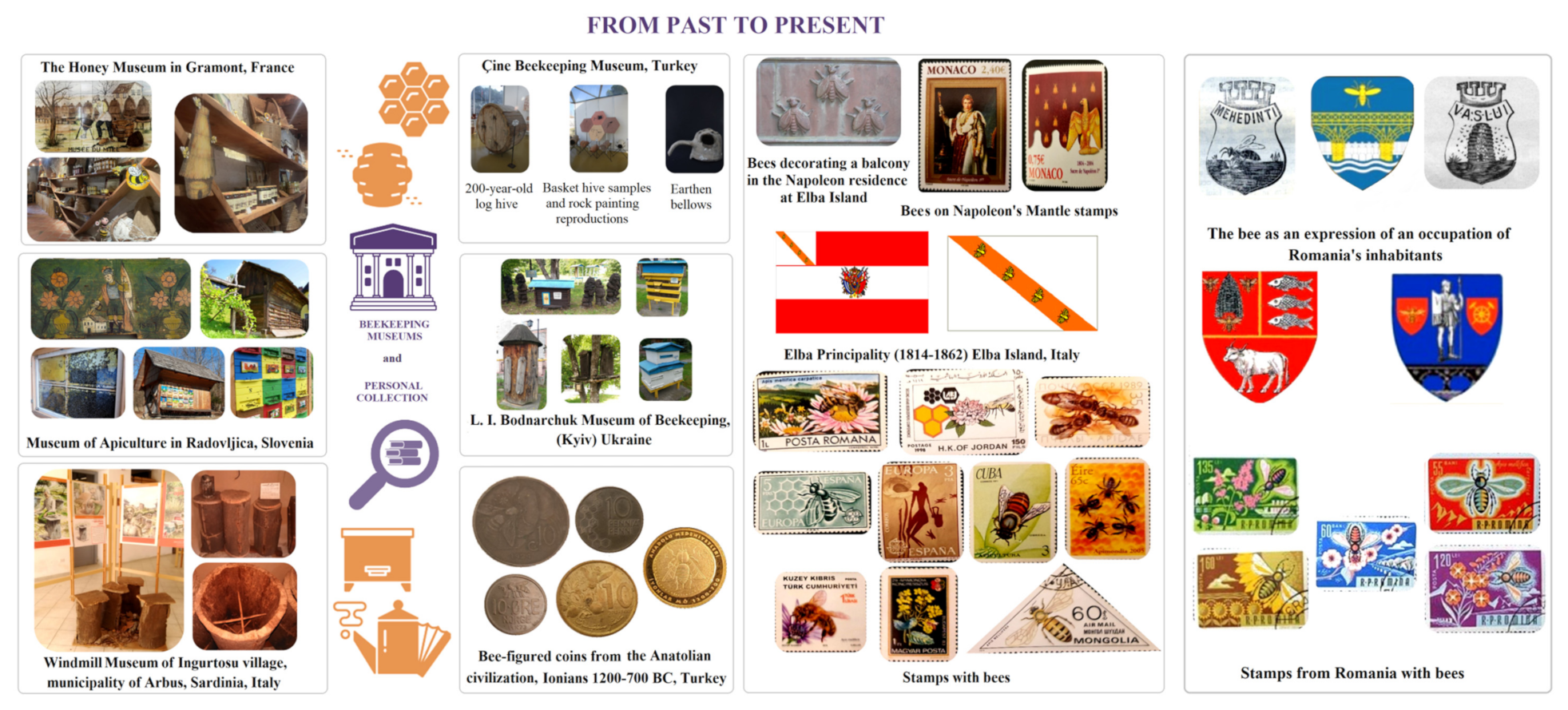
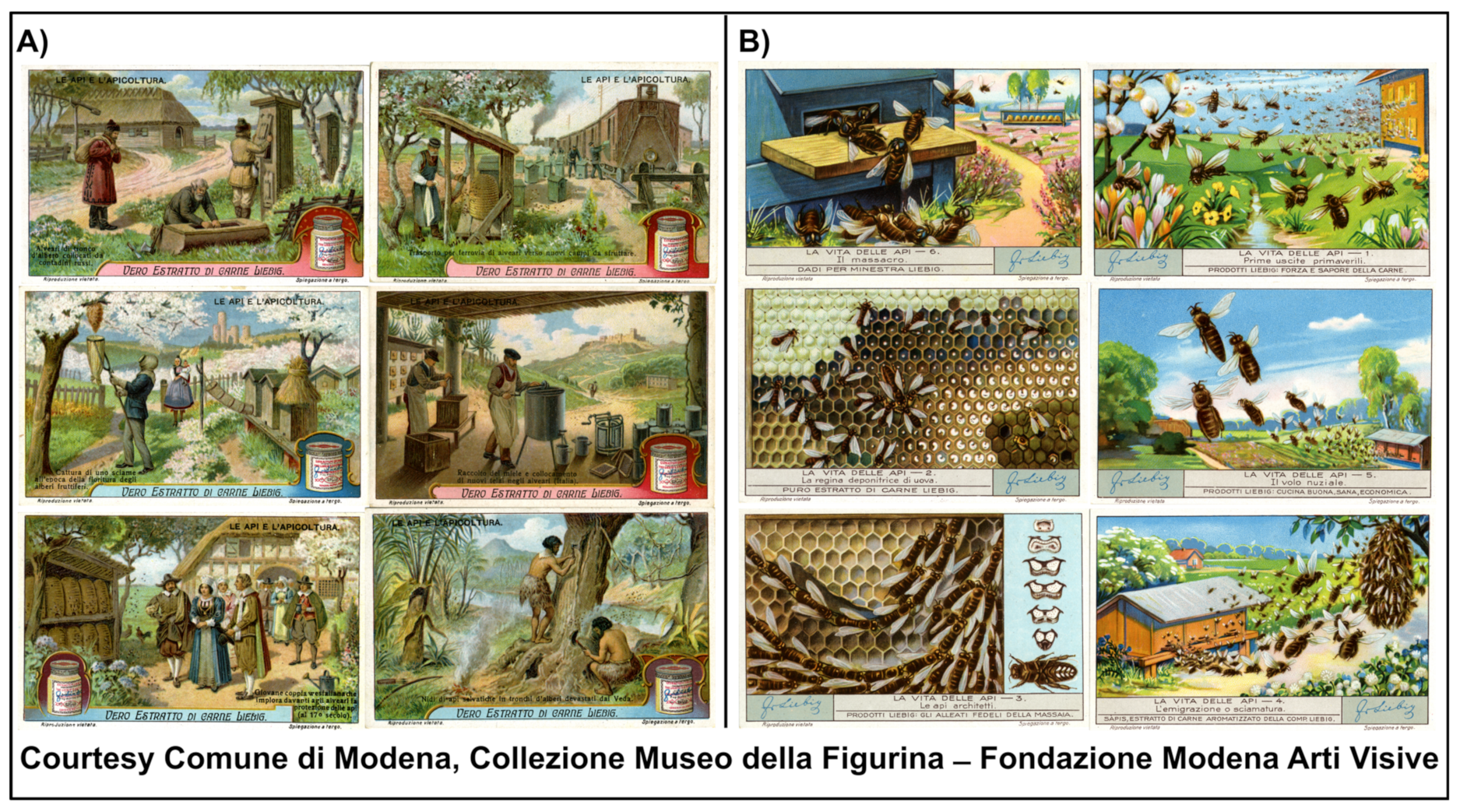
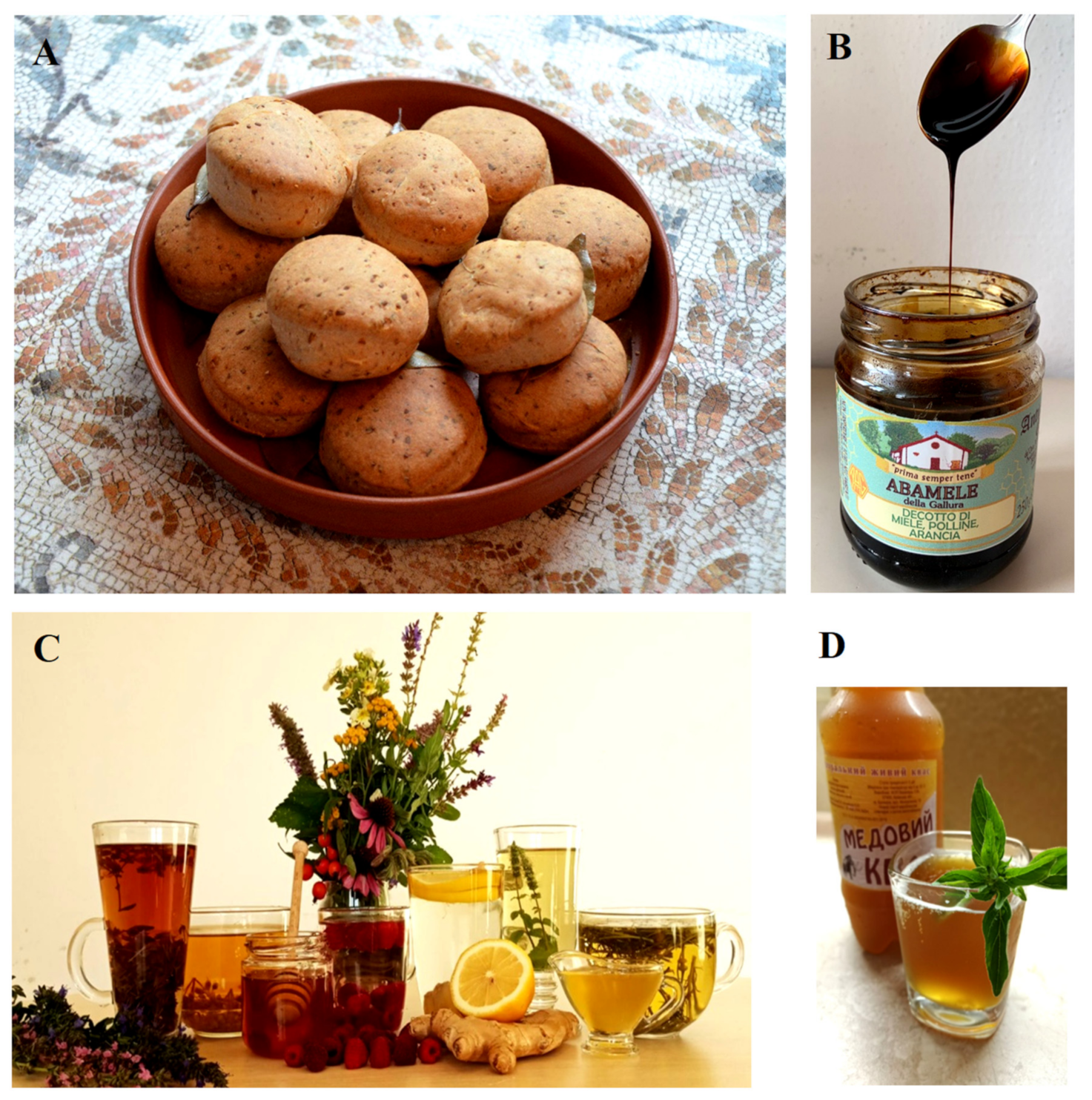
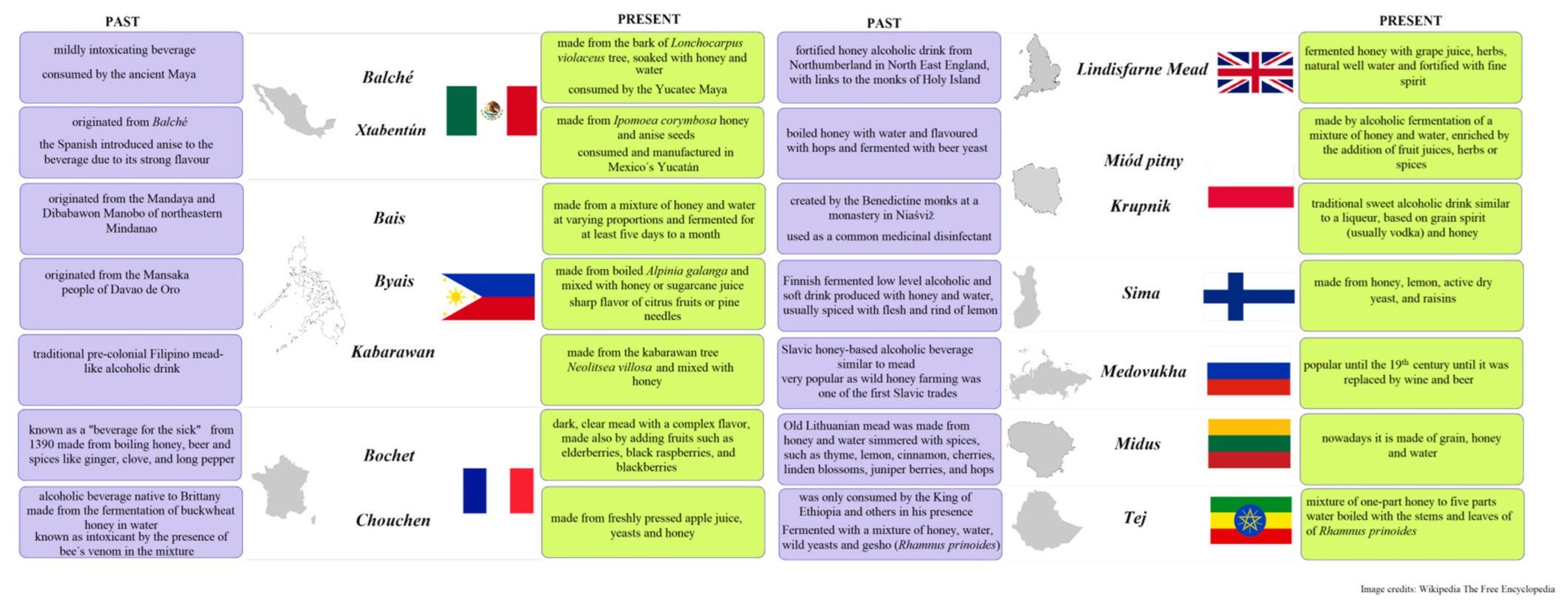
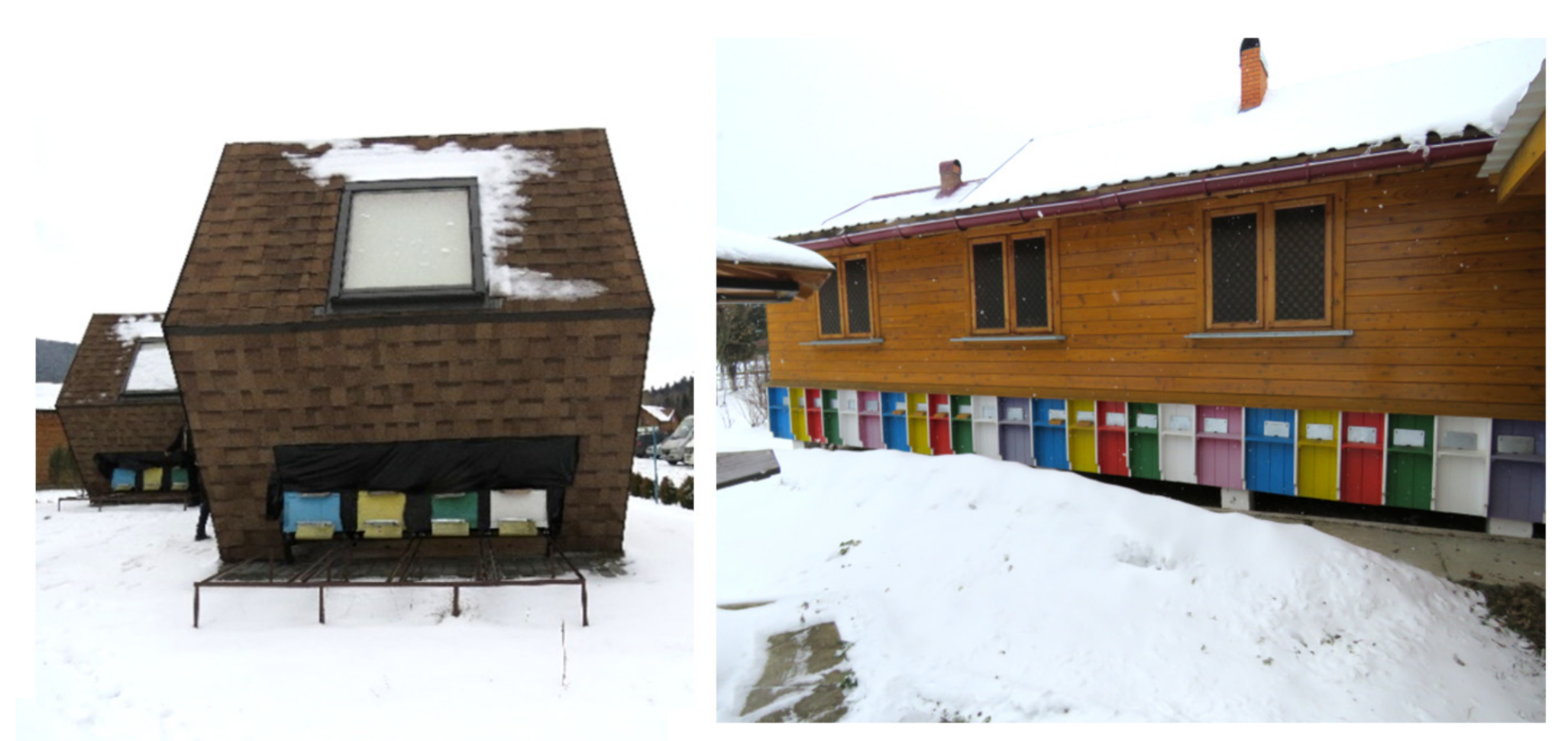
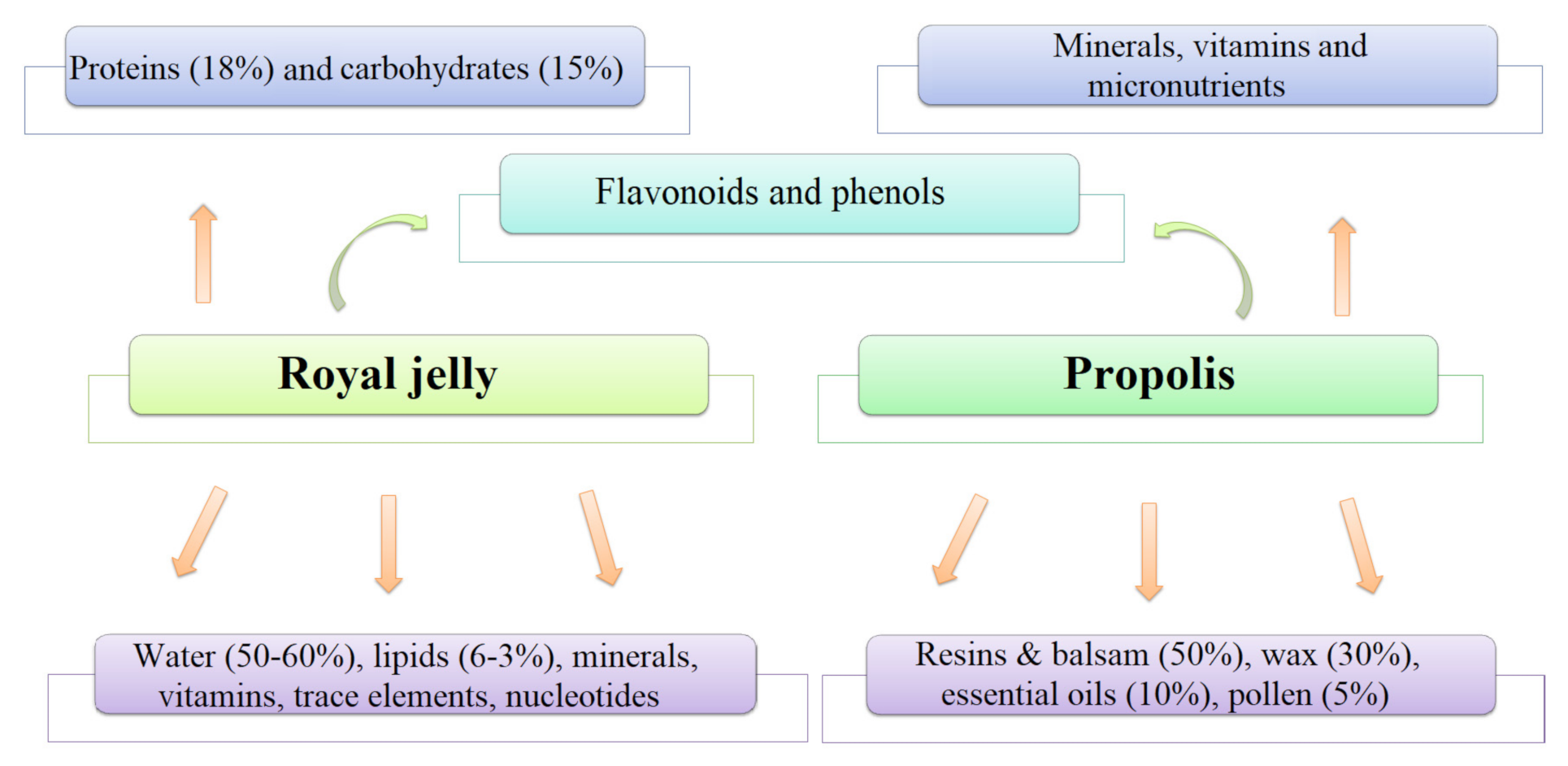

Publisher’s Note: MDPI stays neutral with regard to jurisdictional claims in published maps and institutional affiliations. |
© 2021 by the authors. Licensee MDPI, Basel, Switzerland. This article is an open access article distributed under the terms and conditions of the Creative Commons Attribution (CC BY) license (https://creativecommons.org/licenses/by/4.0/).
Share and Cite
Topal, E.; Adamchuk, L.; Negri, I.; Kösoğlu, M.; Papa, G.; Dârjan, M.S.; Cornea-Cipcigan, M.; Mărgăoan, R. Traces of Honeybees, Api-Tourism and Beekeeping: From Past to Present. Sustainability 2021, 13, 11659. https://doi.org/10.3390/su132111659
Topal E, Adamchuk L, Negri I, Kösoğlu M, Papa G, Dârjan MS, Cornea-Cipcigan M, Mărgăoan R. Traces of Honeybees, Api-Tourism and Beekeeping: From Past to Present. Sustainability. 2021; 13(21):11659. https://doi.org/10.3390/su132111659
Chicago/Turabian StyleTopal, Erkan, Leonora Adamchuk, Ilaria Negri, Mustafa Kösoğlu, Giulia Papa, Maria Sorina Dârjan, Mihaiela Cornea-Cipcigan, and Rodica Mărgăoan. 2021. "Traces of Honeybees, Api-Tourism and Beekeeping: From Past to Present" Sustainability 13, no. 21: 11659. https://doi.org/10.3390/su132111659
APA StyleTopal, E., Adamchuk, L., Negri, I., Kösoğlu, M., Papa, G., Dârjan, M. S., Cornea-Cipcigan, M., & Mărgăoan, R. (2021). Traces of Honeybees, Api-Tourism and Beekeeping: From Past to Present. Sustainability, 13(21), 11659. https://doi.org/10.3390/su132111659









